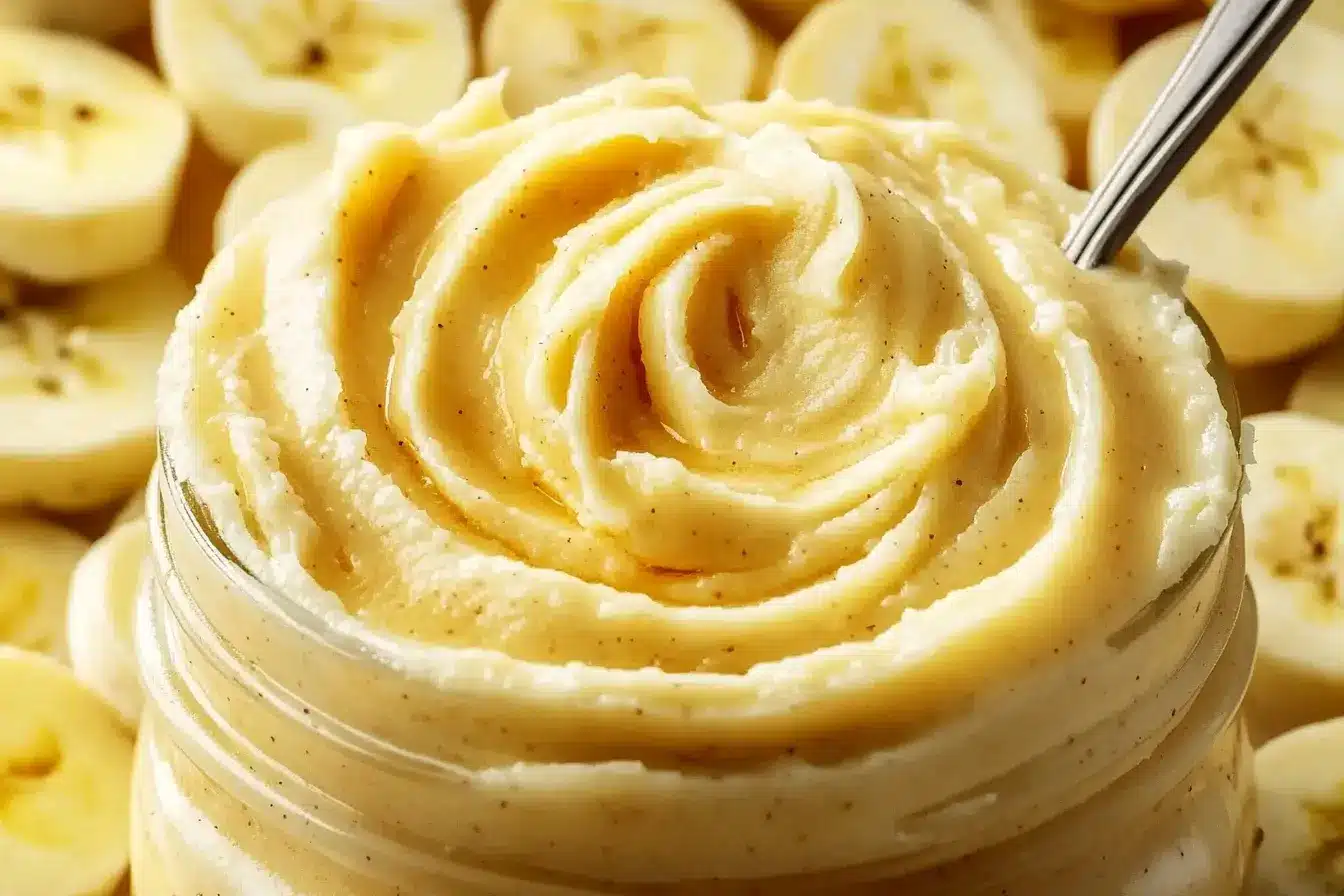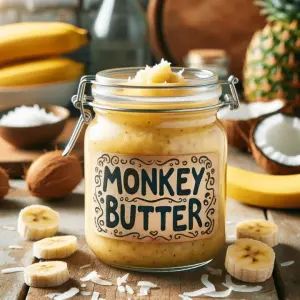Attention all food lovers and adventurous cooks! Are you ready to discover a delightful, versatile spread that will tantalize your taste buds and elevate your everyday meals? Look no further than the incredible Monkey Butter recipe! This delectable concoction has been gaining popularity among food enthusiasts for its unique blend of flavors and ease of preparation. In this article, we’ll dive into the world of Monkey Butter, exploring its origins, ingredients, and step-by-step instructions to help you create this amazing spread in the comfort of your own kitchen.

What is Monkey Butter?
Monkey Butter is a sweet, creamy spread made primarily from ripe bananas, coconut, and a touch of warm spices. Its smooth, luscious texture and tropical flavor profile make it a perfect addition to a wide range of dishes, from breakfast staples like toast and pancakes to decadent desserts like ice cream and pie fillings. The beauty of Monkey Butter lies in its versatility and adaptability, allowing you to experiment with different fruit combinations and flavor variations to suit your personal taste preferences.
The origin of Monkey Butter is somewhat mysterious, with various stories and legends surrounding its creation. Some say it originated in the Caribbean, where an abundance of bananas and coconuts inspired creative cooks to combine these ingredients into a delightful spread. Others claim it was invented by a resourceful mother trying to find a tasty way to use up overripe bananas. Regardless of its true origin, Monkey Butter has quickly gained a devoted following among food lovers worldwide.
Ingredients and Tools Needed
Before we embark on our Monkey Butter-making journey, let’s gather the necessary ingredients and tools. Here’s what you’ll need:
Ingredients:
– 4 cups ripe bananas, mashed (about 8-10 medium bananas)
– 1 cup granulated sugar
– 1 cup brown sugar
– 1 cup shredded coconut
– 1 tsp ground cinnamon
– 1/2 tsp ground nutmeg
– 1/4 tsp salt
– 1 tbsp vanilla extract
– 1 tbsp lemon juice
Tools:
– Large pot or Dutch oven
– Wooden spoon or silicone spatula
– Measuring cups and spoons
– Jars with lids for storage
– Canning equipment (optional, if canning for long-term storage)
– Immersion blender (optional, for a smoother texture)
– Food processor or blender (optional, for processing the bananas and coconut)
When selecting your ingredients, pay special attention to the ripeness of your bananas. Overripe bananas with plenty of brown spots will yield the sweetest, most flavorful Monkey Butter. If your bananas are not quite ripe enough, you can speed up the ripening process by placing them in a paper bag with an apple or tomato overnight.
Preparing the Ingredients
To ensure the best results, it’s important to properly prepare your ingredients before starting the cooking process. Here’s how to get everything ready:
- Peel the bananas and place them in a large bowl. Using a fork or potato masher, mash the bananas until smooth and creamy. If you prefer a smoother texture, you can process the bananas in a food processor or blender.
- If you’re using fresh coconut, crack open the coconut and remove the meat. Grate the coconut meat using a box grater or process it in a food processor until finely shredded. If using pre-packaged shredded coconut, measure out the required amount.
- Measure out the sugar, spices, vanilla extract, and lemon juice, and set them aside.
Now that your ingredients are prepped and ready to go, it’s time to start cooking!
Cooking Instructions
- In a large pot or Dutch oven, combine the mashed bananas, granulated sugar, brown sugar, shredded coconut, cinnamon, nutmeg, and salt. Stir well to combine, making sure the ingredients are evenly distributed.
- Place the pot over medium heat and bring the mixture to a boil, stirring frequently to prevent scorching. As the mixture heats up, the sugars will melt, and the bananas will release their liquid, creating a soupy consistency.
- Once the mixture reaches a boil, reduce the heat to low and allow it to simmer for 30-40 minutes. Stir the mixture occasionally, scraping the bottom and sides of the pot to prevent sticking and ensure even cooking.
- As the Monkey Butter cooks, it will thicken and darken in color. Continue cooking until it reaches a thick, spreadable consistency, similar to that of jam or preserves. Keep in mind that the Monkey Butter will thicken further as it cools.
- Once the desired consistency is reached, remove the pot from the heat and stir in the vanilla extract and lemon juice. Mix well to incorporate these final flavors.
- If you prefer a smoother texture, use an immersion blender to puree the Monkey Butter directly in the pot. Be careful, as the mixture will be hot.
- Allow the Monkey Butter to cool slightly before transferring it to clean jars for storage.
Tip: If you find that your Monkey Butter is too thick after cooking, you can thin it out by stirring in a small amount of water or banana juice until you reach the desired consistency.
Canning and Storage
If you want to enjoy your Monkey Butter for an extended period, canning is an excellent option. Here’s how to can your Monkey Butter for long-term storage:
- Sterilize your jars and lids by boiling them in water for 10 minutes. This step is crucial to ensure that your jars are free from bacteria and other contaminants that could spoil your Monkey Butter.
- Carefully remove the sterilized jars from the boiling water using canning tongs, and place them on a clean, dry towel.
- Ladle the hot Monkey Butter into the sterilized jars, leaving 1/4 inch of headspace at the top. This headspace allows room for the Monkey Butter to expand during the canning process.
- Wipe the rims of the jars with a clean, damp cloth to remove any residue or spills. This step ensures a proper seal.
- Place the lids and rings on the jars and tighten until fingertip-tight. Do not overtighten, as this can prevent the jars from sealing properly.
- Place the jars in a boiling water bath, making sure they are covered by at least 1 inch of water. Process the jars for 10 minutes, adjusting the time if necessary for your altitude.
- Using canning tongs, carefully remove the jars from the water bath and place them on a clean, dry towel. Allow the jars to cool completely, undisturbed, for 12-24 hours.
- After cooling, check the seals on the jars by pressing down on the center of each lid. If the lid does not flex or pop back up, the jar is properly sealed. If any jars have not sealed, refrigerate them and use them within 2 weeks.
Properly canned Monkey Butter can last up to a year when stored in a cool, dry location away from direct sunlight. Be sure to label your jars with the date and contents for easy reference.
If you prefer not to can your Monkey Butter, it can be stored in the refrigerator for up to 2 weeks in an airtight container.
Monkey Butter Recipe Serving Suggestions
Now that you’ve made your delicious Monkey Butter, it’s time to explore the many ways you can enjoy it! Here are some serving suggestions to get you started:
– Breakfast spreads: Spread Monkey Butter on toast, bagels, English muffins, or croissants for a delightful breakfast treat. It pairs wonderfully with a hot cup of coffee or tea.
– Pancakes and waffles: Use Monkey Butter as a topping for pancakes, waffles, or French toast. Its creamy texture and tropical flavor will elevate your breakfast game to new heights.
– Dessert applications: Swirl Monkey Butter into your favorite ice cream, yogurt, or pudding for a tropical twist. Use it as a filling for cakes, cupcakes, or pastries, or as a topping for cheesecake or pie.
– Sandwich spread: Pair Monkey Butter with peanut butter or almond butter for a tasty, protein-packed sandwich spread. It’s perfect for school lunches or as a quick snack.
– Fruit dip: Use Monkey Butter as a dip for fresh fruit like apples, pears, or strawberries. Its creamy texture and sweet flavor make it a healthier alternative to traditional dessert dips.
– Oatmeal and porridge: Stir a spoonful of Monkey Butter into your morning oatmeal or porridge for a tropical twist on a classic breakfast staple.
Feel free to get creative and experiment with your own serving ideas – the possibilities are endless!
Monkey Butter Recipe Variations
One of the wonderful things about Monkey Butter is its versatility. You can easily customize the recipe by adding different fruits or adjusting the sweetness and spices to your liking. Here are a few ideas to inspire your culinary creativity:
– Mango Monkey Butter: Substitute half of the bananas with ripe, diced mangoes for a tropical twist. The combination of bananas and mangoes creates a bright, sunny flavor that’s perfect for summer.
– Strawberry Monkey Butter: Add 1-2 cups of hulled and chopped strawberries to the recipe for a fruity, pink-hued spread. The sweetness of the strawberries complements the bananas and coconut beautifully.
– Spiced Monkey Butter: Increase the amount of cinnamon and nutmeg, or add a pinch of ground cloves or ginger for a warmly spiced flavor. This variation is perfect for the cooler months or for those who love the cozy flavors of fall and winter.
– Less-Sweet Monkey Butter: Reduce the amount of sugar in the recipe by 1/4 to 1/2 cup for a less sweet, more banana-forward taste. This variation is ideal for those who prefer a less sugary spread or who want to highlight the natural sweetness of the bananas.
– Chocolate Monkey Butter: Add 1/2 cup of cocoa powder to the recipe for a rich, chocolatey twist on classic Monkey Butter. This variation is perfect for satisfying your chocolate cravings while still enjoying the fruity, tropical flavors of bananas and coconut.
– Nut Butter Monkey Butter: Stir in 1/2 cup of your favorite nut butter (peanut butter, almond butter, or cashew butter) for a protein-packed, extra creamy spread. This variation is great for adding a boost of healthy fats and protein to your breakfast or snack routine.
Remember, these are just a few ideas to get you started. Feel free to get creative and come up with your own unique Monkey Butter variations based on your favorite flavors and ingredients!
Monkey Butter Recipe Expert Tips
To ensure your Monkey Butter turns out perfectly every time, keep these expert tips in mind:
– Use very ripe bananas: The key to a flavorful, naturally sweet Monkey Butter is using bananas that are heavily speckled with brown spots. These overripe bananas will yield the best taste and texture.
– Stir frequently: To prevent scorching and ensure even cooking, stir the Monkey Butter mixture frequently, especially during the first few minutes of cooking when the sugars are melting and the bananas are releasing their liquid.
– Adjust cooking time as needed: Cooking times may vary depending on factors like the ripeness of your bananas, the moisture content of your coconut, and the heat of your stove. Keep an eye on your Monkey Butter as it cooks, and adjust the cooking time as necessary to achieve your desired consistency.
– Use clean, sterilized jars: If canning your Monkey Butter for long-term storage, be sure to use clean, properly sterilized jars to ensure a safe, shelf-stable product. Follow proper canning procedures to avoid contamination and spoilage.
Common mistakes to avoid:
– Using under-ripe bananas: Bananas that are not fully ripe will result in a less flavorful, less sweet Monkey Butter. Be patient and wait for your bananas to develop plenty of brown spots before using them in this recipe.
– Overcooking the mixture: Cooking the Monkey Butter for too long can cause it to become too thick, dark, and difficult to spread. Keep a close eye on the mixture as it cooks, and remove it from the heat once it reaches your desired consistency.
– Not stirring enough: Failing to stir the Monkey Butter mixture frequently can lead to scorching and uneven cooking. Be sure to stir the mixture regularly, especially in the beginning stages of cooking.
– Improperly canning the Monkey Butter: If not canned properly, your Monkey Butter may spoil or develop harmful bacteria. Follow proper canning procedures, including sterilizing your jars and lids, leaving adequate headspace, and processing the jars for the appropriate time.
By keeping these expert tips in mind and avoiding common mistakes, you’ll be well on your way to creating the perfect batch of Monkey Butter every time!
FAQs
- Can I use frozen fruit instead of fresh fruit?
Yes, you can use frozen bananas or other fruits in this recipe. Just be sure to thaw them completely and drain any excess liquid before using.
- Can I reduce the amount of sugar?
Absolutely! You can reduce the sugar by 1/4 to 1/2 cup, depending on your taste preferences and the sweetness of your bananas.
- How long does Monkey Butter last?
Properly canned Monkey Butter can last up to a year when stored in a cool, dry place. If not canned, it can be stored in the refrigerator for up to 2 weeks.
- Can I add other fruits?
Yes, you can add or substitute other fruits like mangoes, strawberries, or peaches to create your own unique Monkey Butter variations.
- Is Monkey Butter gluten-free?
Yes, this recipe is naturally gluten-free, as it does not contain any wheat-based ingredients. However, always check the labels of your ingredients to ensure they are certified gluten-free if you have a severe gluten allergy or intolerance.
Conclusion
Congratulations on mastering the art of making Monkey Butter! This delightful spread is sure to become a household favorite, thanks to its irresistible flavor, creamy texture, and endless versatility. Whether you enjoy it on your morning toast, as a dessert topping, or as a secret ingredient in your favorite recipes, Monkey Butter is a delicious addition to any kitchen.
We hope this article has inspired you to try your hand at making Monkey Butter and experimenting with your own creative variations. Don’t forget to share your delicious creations with friends and family – they’ll be thrilled to discover this tasty treat!
Happy cooking and enjoy your homemade Monkey Butter!

